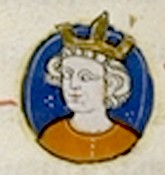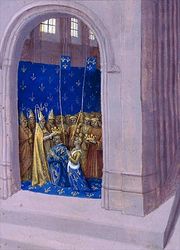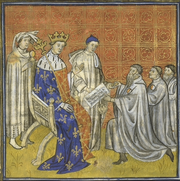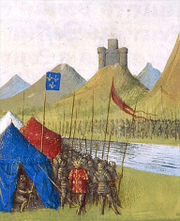Louis X of France
| Louis X & I | |
|---|---|
 |
|
| Louis X of France, a contemporary picture from the L'arbre généalogique Bernard Gui, Généalogie des rois de France' | |
|
|
|
| Reign | 29 November 1314 – 5 June 1316 |
| Coronation | 24 August 1315 |
| Predecessor | Philip IV |
| Successor | John I |
|
|
|
| Reign | 4 April 1305 – 5 June 1316 |
| Predecessor | Joan I and Philip I |
| Successor | John I |
| Spouse | Margaret of Burgundy Clementia of Hungary |
| Issue | |
| Joan II of Navarre John I of France |
|
| House | House of Capet |
| Father | Philip IV of France |
| Mother | Joan I of Navarre |
| Born | 4 October 1289 Paris, France |
| Died | 5 June 1316 (aged 26) Vincennes, Val-de-Marne, France |
| Burial | Saint Denis Basilica |
Louis X of France, (4 October 1289 – 5 June 1316), called the Quarreler, the Headstrong, or the Stubborn (French: le Hutin; Spanish: el Obstinado) was the King of Navarre (as Louis I) from 1305 and King of France from 1314 until his death. Louis' short reign saw the freeing of the French serfs and the readmittance of French Jews to the kingdom.
Contents |
Personality, marriage and coronation

Louis was born in Paris, the eldest son of Philip IV of France and Joan I of Navarre.[1] He inherited the crown of Navarre on the death of his mother, on 2 April 1305. On 21 September 1305, at age 16, he married Margaret of Burgundy and they had a daughter, Joan. Louis was known as "the Quarreler" as the result of the tensions prevailing throughout his reigns.[2]
Both Louis and Margaret became involved in the Tour de Nesle affair towards the end of Philip's reign. In 1314, Margaret, Blanche and Joan—the latter two being the wives of Louis' brothers Charles and Philip, respectively—were arrested on charges of infidelity.[3] Margaret and Blanche were both tried before the French parliament later that year and found guilty. Their alleged lovers were executed, and the women had their hair shorn and were sentenced to life imprisonment.[4] Philip stood by his wife Joan, who was ultimately found innocent and released. Louis, however, had not enjoyed a happy marriage to Margaret and requested that the marriage be annulled, with Margaret being imprisoned in poor conditions in the castle of Château Gaillard.[5]
On the death of his father in 1314, Louis became King of France. Margaret died under suspicious circumstances, possibly murdered, on 14 August 1315 at Château-Gaillard. Louis remarried five days later, on 19 August to Clementia of Hungary, the daughter of Charles Martel of Anjou and the niece of Louis' own uncle and close advisor, Charles of Valois. Louis and Clementia were crowned at Reims on 24 August 1315.
Domestic policy

Louis was king of Navarre for eleven years and king of France for less than two years. His reign was dominated by continual feuding with the noble factions within the kingdom, and major reforms designed to increase royal revenues, such as the freeing of the French serfs and the readmittance of the Jews.
Regional Leagues
By the end of Philip IV's reign opposition to the fiscal reforms were growing. With Philip's death and the accession of Louis, this opposition rapidly developed in more open revolt, some authors citing Louis' relative youth as one of the reasons behind the timing of the rebellions.[6] Leagues of regional nobles began to form around the country, demanding changes.[7] Charles of Valois took advantage of this movement to turn against his old enemy, Philip IV's former minister and chamberlain Enguerrand de Marigny and convinced Louis to bring corruption charges against him. When these failed, Charles then convinced Louis to bring sorcery charges against him instead, which proved more effective and led to de Marigny's execution at Vincennes in April 1315.[8] Other former ministers were similarly prosecuted.[9] This, combined with the halting of Philip's reforms, the issuing of numerous charters of rights[10] and a reversion to more traditional rule, largely assuaged the regional leagues.[11]
Readmittance of the Jews and reform of serfdom
Louis continued to require revenues, however, and alighted on a reform of French serfdom as a way of achieving this. Arguing that all men are born free, Louis declared in 1315 that French serfs would be freed, although each serf would have to pay for the privilege.[12] A body of commissioners was established to undertake the reform, establishing the peculium, or value, of each serf.[13] For serfs owned directly by the King, all of the peculium would be received by the Crown - for serfs owned by subjects of the King, the amount would be divided between the Crown and the owner.[14] In the event, not all serfs were prepared to pay in this fashion and in due course Louis declared that the goods of these serfs would be seized anyway, with the proceeds going to pay for the war in Flanders.[15]
Louis was also responsible for a key shift in policy towards the Jews. In 1306, his father, Philip IV, had expelled the Jewish minority from across France, a "shattering" event for most of these communities.[16] Louis began to reconsider this policy, motivated by the additional revenues that might be forthcoming to the Crown if the Jews were allowed to return.[17] Accordingly Louis issued a charter in 1315, readmitting the Jews subject to various conditions. The Jews would only be admitted back into France for twelve years, after which the agreement might be terminated; Jews were to wear an armband at all times; Jews could only live in those areas where there had been previously been Jewish communities; Jews were initially to be forbidden from usury.[18] This was the first time that French Jews had been covered by such a charter, and Louis was careful to justify his decision with reference to the policies of his ancestor Saint Louis IX, the position of Pope Clement V and an argument that the people of France had demanded a return of the Jews.[19] The result was a much weakened Jewish community that depended directly upon the King for their right of abode and protection.[20]
The challenge of Flanders

Louis continued to seek a military solution to the ongoing Flanders problem. The Count of Flanders ruled an "immensely wealthy state"[21] which largely led an autonomous existence on the edge of the French state; the French king was generally regarded as having suzerainty over Flanders, but in recent years the relationship had become strained.[22] Philip IV had been defeated at Courtrai in 1302 attempting to reassert French control, where he was defeated by Robert II of Artois,[23] and despite the later French victory at the Battle of Mons-en-Pévèle the relationship remained tense.
Louis attempted to deliver a military solution, mobilising an army along the border, but the French position rapidly become strained by the need to maintain a wartime footing. Louis X had prohibited exports of grain and other material to Flanders in 1315. This proved challenging to enforce, and Louis had to apply pressure to Edward II of England in order to prevent Spanish vessels trading with the embargoed Flemish,[24] and to local Church leaders in the border area.[25] An unintended result of Louis' policy was the development of a profitable smuggling industry that in turn discouraged legal trade with the French crown along the border region; Louis was also forced to directly requisition food for his forces, resulting in a string of complaints from local lords and the Church.[26]
Death and legacy
Louis was a keen player of jeu de paume, or real tennis, and became notable as the first person to construct indoor tennis courts in the modern style. Louis was unhappy with playing tennis out of doors and accordingly had indoor, enclosed courts made in Paris "around the end of the 13th century".[27] In due course this design spread across royal palaces all over Europe.[28] Unfortunately, in June 1316 at Vincennes, Val-de-Marne and following a particularly exhausting game, Louis drank a large quantity of cooled wine and subsequently died of either pneumonia or pleurisy, although there was also suspicion of poisoning.[29] Because of the contemporary accounts of his death, Louis is history's first tennis player known by name.[30] He and his second wife Clementia are interred in Saint Denis Basilica.
Louis' wife Clementia was pregnant at the time of his death, leaving the succession in doubt. Under the recently reaffirmed Salic Law, a son would have primacy over Louis' first daughter, Joan.[31] A daughter, however, would have a weaker claim to the throne, and would need to compete with Joan's own claims - although suspicions hung over Joan's parentage following the scandal in 1314.[32] As a result Louis' brother Philip was appointed regent for the five months remaining until the birth of his brother's child. The baby, who turned out to be male, lived only five days, until 20 November 1316—an extremely short reign for Louis's posthumous son, John I. Louis' brother Philip then succeeded in pressing his claims king of France and also of Navarre, being known there as Philip II of Navarre.
References
| French Monarchy |
|---|
| Direct Capetians |
.svg.png) |
| Louis X |
| Joan II of Navarre |
| John I |
- ↑ Baynes, p.18.
- ↑ Konta, p.521.
- ↑ Weir, p.99.
- ↑ Weir, pp99-100.
- ↑ Weir, p.100.
- ↑ Sellery, p.292.
- ↑ Wagner, p.203.
- ↑ Lea, p.451.
- ↑ Emmerson and Clayton-Emmerson, p.528.
- ↑ Emmerson and Clayton-Emmerson, p.528.
- ↑ Wagner, p.203.
- ↑ Bishop, p.296.
- ↑ Stephen, p.377.
- ↑ Stephen, p.377.
- ↑ Jeudwine, p.18.
- ↑ Chazan, p.79.
- ↑ Chazan, p.79.
- ↑ Chazan, pp79-80.
- ↑ Chazan, p.79.
- ↑ Chazan, p.79.
- ↑ Holmes, p.16.
- ↑ Holmes, p.16.
- ↑ Holmes, p.16.
- ↑ Kulsrud, p.212.
- ↑ Jordan, pp151-2.
- ↑ Jordan, pp.169-170.
- ↑ Newman, p.163.
- ↑ Newman, p.163.
- ↑ Gillmeister, pp. 17-21.
- ↑ Gillmeister, pp.17-21.
- ↑ Rose, p.89.
- ↑ Wagner, p.250.
Bibliography
- Baynes, Thomas Spencer (ed). (1890) The Encyclopædia Britannica. Henry G. Allen Company.
- Bishop, Morris. (2001) The Middle Ages. Houghton Mifflin Harcourt.
- Chazan, Robert. (1979) Church, State, and Jew in the Middle Ages. Behrman House.
- Emmerson, Richard Kenneth and Sandra Clayton-Emmerson. (2006) Key Figures in Medieval Europe: an Encyclopedia. New York: Routledge.
- Gillmeister, Heiner. (1998) Tennis: A Cultural History. London: Leicester University Press. ISBN 978-0718501471.
- Holmes, George. (2000) Europe, Hierarchy and Revolt, 1320–1450, 2nd edition. Oxford: Blackwell.
- Jeudwine, John Wynne. (1983) Tort, Crime, and Police in Mediaeval Britain: a review of some early law and custom. London: Wm. S. Hein Publishing.
- Jordan, William Chester. (1996) The Great Famine: Northern Europe in the early Fourteenth Century. Princeton: Princeton University Press.
- Konta, Annie Lemp. (1914) The History of French literature from the Oath of Strasburg to Chanticler. London: D. Appleton and Company.
- Kulsrud, Carl Jacob. (2005) Maritime Neutrality to 1780: a history of the main principles governing neutrality and belligerency to 1780. Clark: Law Book Exchange.
- Lea, Henry Charles. (1887) A History of the Inquisition of the Middle Ages, Part Three. London: Harper.
- Newman, Paul B. (2001) Daily Life in the Middle Ages. Jefferson: McFarland.
- Rose, Hugh James. (1857) A New General Biographical Dictionary, Volume 11. London: Fellows.
- Sellery, George C. (2007) The Founding of Western Civilization. Read Book.
- Stephen, James. (2008) Lectures on the History of France. Read Book.
- Wagner, John. A. (2006) Encyclopedia of the Hundred Years War. Westport: Greenwood Press.
- Weir, Alison. (2006) Isabella: She-Wolf of France, Queen of England. London: Pimlico.
Further reading
- Marie-Anne Polo de Beaulieu. (2002) La France au moyen âge : De l'An mil à la Peste noire, 1348.
- Roselyne Callaux. (2002) Robert III d'Artois.
Ancestry
| Ancestors of Louis X of France | ||||||||||||||||||||||||||||||||||||||||||||||||||||||||||||||||||||||||||||||||||||||||||||||||||||||||||||||||||||||||||||||||||||||||||||||||||||||||||||||||||||||||||||||||||||||||||||||||||||||||||||||||||||||||||||||||||||||||||||||||||||||||||||||||||||||||||||||||||||||||||||||||||||||||||||||||||||||||||||||||||||||||||||||||||||||||||||||||||||||||||||||||||||||||||||||||||||||||||||||||||||||||||||||||||||||||||||||||||||||||||||||||||||||||||||||||||||||||||||||||||||||||||||||||||||||||||||||||||||||||||||||||||||||||||||||||||
|---|---|---|---|---|---|---|---|---|---|---|---|---|---|---|---|---|---|---|---|---|---|---|---|---|---|---|---|---|---|---|---|---|---|---|---|---|---|---|---|---|---|---|---|---|---|---|---|---|---|---|---|---|---|---|---|---|---|---|---|---|---|---|---|---|---|---|---|---|---|---|---|---|---|---|---|---|---|---|---|---|---|---|---|---|---|---|---|---|---|---|---|---|---|---|---|---|---|---|---|---|---|---|---|---|---|---|---|---|---|---|---|---|---|---|---|---|---|---|---|---|---|---|---|---|---|---|---|---|---|---|---|---|---|---|---|---|---|---|---|---|---|---|---|---|---|---|---|---|---|---|---|---|---|---|---|---|---|---|---|---|---|---|---|---|---|---|---|---|---|---|---|---|---|---|---|---|---|---|---|---|---|---|---|---|---|---|---|---|---|---|---|---|---|---|---|---|---|---|---|---|---|---|---|---|---|---|---|---|---|---|---|---|---|---|---|---|---|---|---|---|---|---|---|---|---|---|---|---|---|---|---|---|---|---|---|---|---|---|---|---|---|---|---|---|---|---|---|---|---|---|---|---|---|---|---|---|---|---|---|---|---|---|---|---|---|---|---|---|---|---|---|---|---|---|---|---|---|---|---|---|---|---|---|---|---|---|---|---|---|---|---|---|---|---|---|---|---|---|---|---|---|---|---|---|---|---|---|---|---|---|---|---|---|---|---|---|---|---|---|---|---|---|---|---|---|---|---|---|---|---|---|---|---|---|---|---|---|---|---|---|---|---|---|---|---|---|---|---|---|---|---|---|---|---|---|---|---|---|---|---|---|---|---|---|---|---|---|---|---|---|---|---|---|---|---|---|---|---|---|---|---|---|---|---|---|---|---|---|---|---|---|---|---|---|---|---|---|---|---|---|---|---|---|---|---|---|---|---|---|---|---|---|---|---|---|---|---|---|---|---|---|---|---|---|---|---|---|---|---|---|---|---|---|---|---|---|---|---|---|---|---|---|---|---|---|---|---|---|---|---|---|---|---|---|---|---|---|---|---|---|---|---|---|---|---|---|---|---|---|---|---|---|---|---|---|---|---|---|---|---|---|---|---|---|---|---|---|---|---|---|---|---|---|---|---|---|---|---|---|---|---|---|---|---|---|---|---|---|---|---|---|---|---|---|---|---|---|---|---|---|---|---|---|---|---|---|---|---|---|---|---|---|---|---|---|---|---|---|---|---|---|---|---|---|---|---|
|
||||||||||||||||||||||||||||||||||||||||||||||||||||||||||||||||||||||||||||||||||||||||||||||||||||||||||||||||||||||||||||||||||||||||||||||||||||||||||||||||||||||||||||||||||||||||||||||||||||||||||||||||||||||||||||||||||||||||||||||||||||||||||||||||||||||||||||||||||||||||||||||||||||||||||||||||||||||||||||||||||||||||||||||||||||||||||||||||||||||||||||||||||||||||||||||||||||||||||||||||||||||||||||||||||||||||||||||||||||||||||||||||||||||||||||||||||||||||||||||||||||||||||||||||||||||||||||||||||||||||||||||||||||||||||||||||||
Fiction
- Maurice Druon - Les rois maudits
External links
|
Louis X of France
House of Capet
Born: October 1289 Died: 5 June 1316 |
||
| Regnal titles | ||
|---|---|---|
| Preceded by Philip IV |
King of France 29 November 1314 – 5 June 1316 |
Succeeded by John I |
| Preceded by Joan I and Philip I |
King of Navarre (as 'Louis I') 4 April 1305 – 5 June 1316 |
|
| French royalty | ||
| Preceded by Charles, Count of Valois |
Heir to the Throne as Heir apparent 4 October 1289 – 29 November 1314 |
Succeeded by Philip, Count of Poitou |
| French nobility | ||
| Preceded by Joan I and Philip I |
Count of Champagne (as 'Louis I') 4 April 1305 – 5 June 1316 |
Succeeded by John I |
|
|||||||||||||||||||||||||||||||||||||||||